Storage Problems. Again.

I’ve made no secret of my strategy that the legs of the tripod of my ability to own 13 cars are a wonderful understanding and tolerant spouse, affordable insurance through Hagerty, and affordable storage. Regarding the storage leg, I’ve written pieces about how I progressed from having access to the two-car garage at my mother’s house … to moving to Newton (Massachusetts) to a property with a rusty corrugated metal one-car garage, to building a three-and-sort-of-four-car garage … to leeching off the fact that for years my engineering job had me working in a cavernous warehouse where I could stash cars … to renting five affordable, individual 24-hour access roll-up garage bays … to losing those and thinking that the solution was to sell our house in the suburbs and move to a car-centric property … to accepting that that wasn’t going to happen anytime soon … and, finally, finding other affordable storage in a giant but somewhat odd warehouse 70 miles away in the town of Monson on the Massachusetts/Connecticut line.
I have a love-hate relationship with the Monson warehouse arrangement. On the positive side, it’s cheap—$70/month per car—and expandable. If I happened into another car I couldn’t pass up, I’d have somewhere to put it. But the downsides are significant. It’s far less convenient than having individual garages with my roll-up doors. And once I’m inside, I sometimes find my cars are blocked in, and I have to find someone who works there to move the offending vehicle (it’s not a dedicated car storage facility). Plus, the landlord rents over-winter storage to RV, trailer, and boat owners, so once the big boys roll in, my cars aren’t going anywhere until spring. Additionally, traffic on the Mass Pike (I-90) has stepped up considerably in recent years, so the drive that Google Maps says should take a bit over an hour is rarely accomplished in less than 90 minutes; it can be two hours if I get caught on a leaf-peeping or college move-in weekend.
Still, $350/month to store five cars is dirt cheap—less than half what I’ve found anywhere else—and the hour-and-a-half-ish drive time is sort of workable, so I continue to go with the devil I’ve come to know.
But now there’s a new factor.
Mold.
It was a very wet summer here in Boston, with drenching rain causing catastrophic flooding in parts of central Massachusetts and Vermont. One of the times I was out in Monson, I found that one of my cars—which are parked in two rows near one of the warehouse walls—was being directly dripped on. I looked up and saw where the leak was causing insulation to pull away from the ceiling. I moved the car one space forward to get it out from both the drip and the potential dropping of insulation, but I didn’t really think too much of it. Big old metal buildings like this often leak. The storage cost is cheap. You get what you pay for.
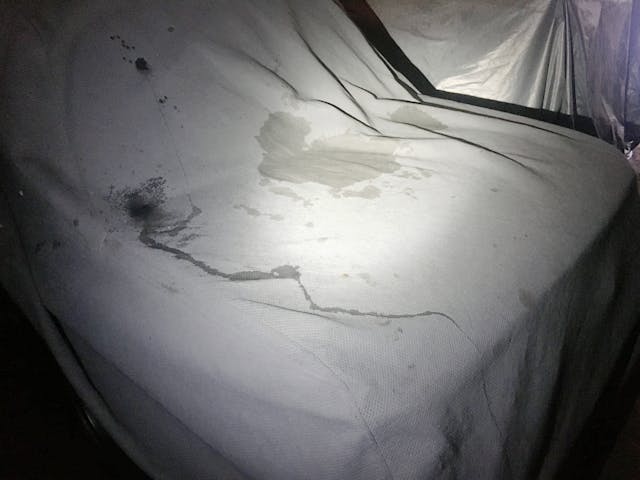
But when I went out there a few weeks ago to swap cars, there were numerous puddles of standing water inside the warehouse, including one spreading under several of my cars. When I pulled the cover off the car I wanted to drive, I was greeted by a substantial bloom of mold on the seats and steering wheel. Concerned, I uncovered and examined all five cars.
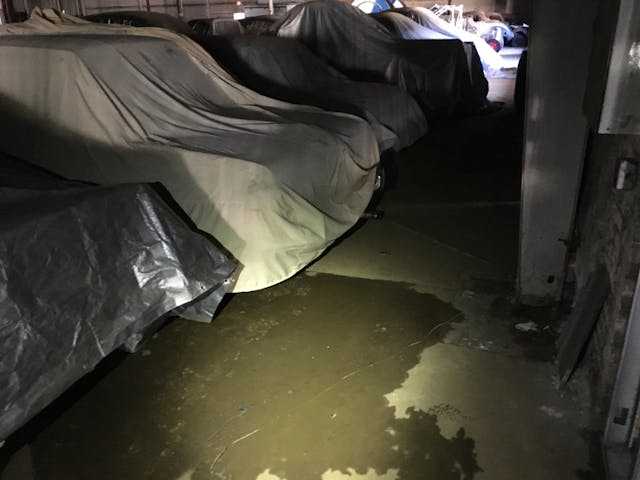
All of the cars had some degree of mold, ranging from near-trivial to no no no no NO! I realized that, on some of the cars, I’d left the windows cracked open, and I found that the correlation was pretty clear—the car with the smallest amount of mold was the furthest from the water and had been left with the windows all the way up. The moldiest car—my ’74 Lotus Europa Twin Cam Special—was sitting in a puddle with the windows rolled partially down (it gets a little mousey-smelling inside the Lotus if you leave it with the windows up).
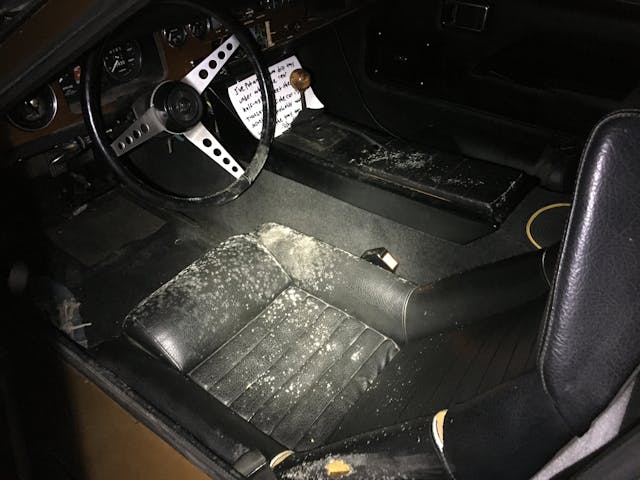
For years, I’ve left a 10-ounce refillable DampRid moisture-absorbing container on the floor of each stored car. These containers have a plastic sink-strainer-like basket that sits in the top. You pour the humidity-absorbent white flakey DampRid crystals into the basket. As the crystals get saturated with water, it drains through the basket into the bottom of the container. As I moved from car to car and emptied the water out of each container, I realized that all of the crystals were gone. In other words, I’d gone too long without visiting the cars and refilling the DampRid containers with fresh desiccant, and the amount of humidity from the rainy summer, the leaky roof, and the water on the floor had overwhelmed them and used them up. So of course the cars were moldy.
I had other constraints on my time and wasn’t able to spend the entire day dealing with the issue, so I did what was efficient and possible. First, there are no assigned marked spaces in the warehouse, so I pulled the cars that were sitting in water one row forward. Next, I keep a gallon of DampRid crystals in the trunk of one of the cars in Monson that I use to refill the containers, but I had nothing to clean the mold with. So I drove to a local hardware store, bought some cleaning wipes, refilled the containers, and wiped off most of the mold. On one of my 2002s, the mold had only bloomed on the hard surfaces of the steering wheel and center console, but on others it had settled onto the rugs. My Bavaria had visible rust blooms on the floor. Fortunately, both the aftermarket Coco mats, as well as the original snap-in floor carpet pieces, were easily removable, so I took them with me for cleaning.
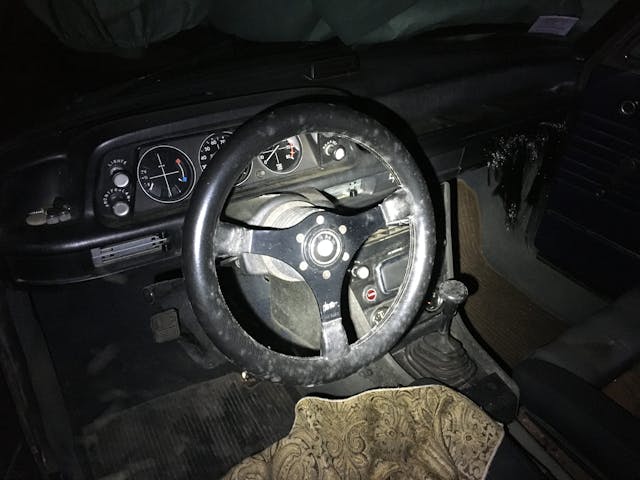
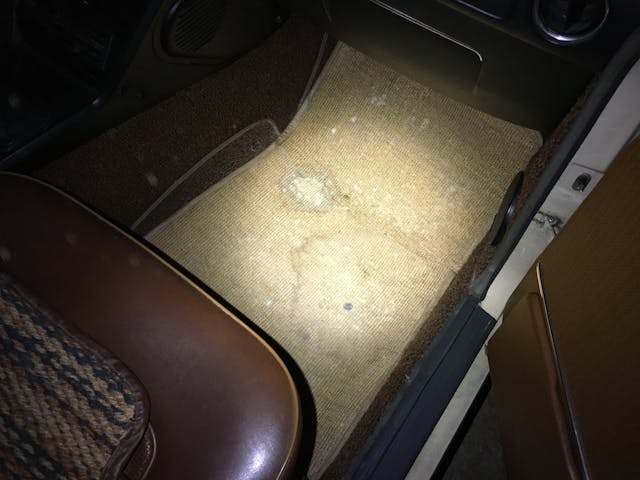
My ’79 Euro 635CSi, however, had a large ugly rust bloom on the passenger-side rug, and it’s a newer-style one-piece rug that can’t be removed without disassembling much of the interior of the car. I wiped the mold off with the cleaning wipes and resolved to come back soon and do a more complete job.
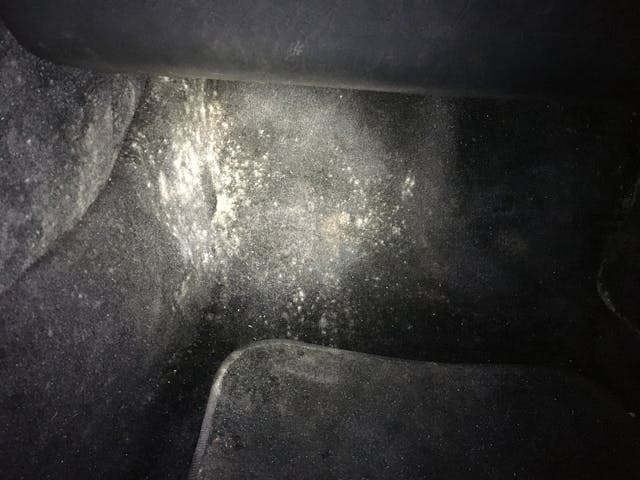
When I got home with the Bavaria’s removable mats and rug pieces, it was easy enough to blast the mold off with a pressure washer and leave them to dry in the sun, but the Monson mold event jarred me. I joke that I don’t consider myself a “collector” because a) I don’t chase investment by buying the most expensive cars in the best condition possible, and b) I sure as hell don’t have climate-controlled storage. But seeing my cars coated in mold in leaky storage was enough to make me think that I’d crossed the line from quirky automotive accumulator to negligent hoarder. I again began pounding on Zillow and doing a deep dive into looking for car-centric properties, but I stopped, as my wife and I never fully agreed on where we would move, and so we’ve stayed put where we are just west of Boston. And that’s OK. Part of my secret to happiness is not craving things I can’t have—don’t ask me about Italian exotics or what some ridiculously mint low-mileage car went for on Bring a Trailer; I pay zero attention.
About a week later, I returned to the Monson warehouse with a second set of five DampRid cannisters and some mold treat/block spray. My plan was to double up on the moisture-absorbing capacity present in each car and spend the better part of the day cleaning them and driving each one to get some fresh air inside. When I got there, I found that two things had changed. First, the puddles had largely dried up. Second, when I checked the existing DampRid in each car, I found that unlike the previous week where the crystals were gone and the canisters had only water in them, this time there was a crust on the DampRid, but no water. More important, I didn’t see any new mold. In other words, with less humidity and ample desiccant, the mold was kept at bay.
Nonetheless, I followed through with the plan. I went through each car one by one. I used the mold cleaner/blocker spray as per the directions—spray it on and wipe off any existing mold. I took each car for a glorious windows-down 30-ish-minute autumn drive, which obviously was not exactly hardship. When I returned to the warehouse, I sprayed the mold cleaner/blocker again to lay down a protective layer. I paid particular attention to spraying all the rug surfaces.

But during all the uncovering-covering action, I noticed something else. One of the covers had evidence of a brown tarry substance dripping on it. I looked up and could see drips of it forming on the undersides of the insulation batting hanging from the metal roof. It was everywhere, but it was worse at the edge of the roof near where it had been leaking.
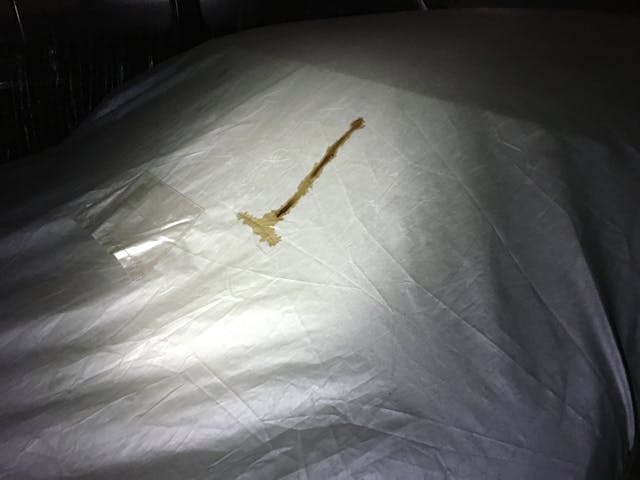

I took two actions. The car with the goo on the cover was the last one that I had parked near the warehouse wall, so I moved it forward. Next, I noticed that many of the other cars in the warehouse had disposable clear plastic covers over them. I always regarded these as a poor substitute for a real indoor cover, but I suddenly understood their utility in helping prevent anything that might drip from the roof from getting through a porous cover and onto the paint. When I got home, I jumped on Amazon and found dozens of choices. I selected the pack that had five covers for $35. The next time I’m out in Monson, I’ll lay them on.

So, I’ve walked myself back from the ledge. I’m not a negligent hoarder. The mold was mostly due to the biblically wet summer, proximity to standing water, and my leaving the cars for too long without changing the desiccant. The simple measures of moving the cars forward, doubling-up on the DampRid, buying a $7 plastic cover for each car, and a commitment to a once-a-month trip to Monson to check on the cars should get me through ’til spring, at which time I can re-evaluate the whole thing again.
After all, this property is waiting for me in western Massachusetts:

***
Rob’s latest book, The Best Of The Hack Mechanic™: 35 years of hacks, kluges, and assorted automotive mayhem is available on Amazon here. His other seven books are available here on Amazon, or you can order personally-inscribed copies from Rob’s website, www.robsiegel.com.
Check out the Hagerty Media homepage so you don’t miss a single story, or better yet, bookmark it. To get our best stories delivered right to your inbox, subscribe to our newsletters.


Ditto on desiccant pouches vs damp rid. I’m not aware of the product you cited but 25 years ago I bought 5 or 10 pounds of silica gel (used for drying flowers) and a yard or two of muslin and sewed up my own pouches, placing them right on the seats and carpets. I never had to deal with the moisture situation you had but it was an old poultry barn and I didn’t know what to expect. Anyway, after winter storage, the pouches could be dryed in an oven or microwave and very reusable. My ultimate solution was retiring to the south and driving my cars year round.
Gary, did you previously live in NJ and owned a Dino?
My 2 summer cars, 94 XJS and 67 MGB, live in my old non heated 2 car detached garage that is not even close to being sealed up. Here in the cold northeast I have no mold problems but occasional critter damage. As a pervious BMW owner of 30 years the first thing I read in my Roundel club magazine every month was Rob’s articles. Still go right to his stories whenever I see them. I can usually relate to his predicaments!
My dad always had a dozen or so cars around when I was growing up and about a third of them would generally not be drivable at any given time. They sometimes seemed to cause more stress than pleasure — like the cars owned him and not the other way around.
Several years ago, I had four “toy” cars and that was too many for me — one or two were perpetually neglected. Today, I’m at one daily driver each for my wife and I, plus two fun cars we both can enjoy. I’m finding this to be less stressful and each car gets used more.
I never considered off-site storage because I don’t need any additional hurdles to getting in a car and taking it for a drive. That said, if it works for the author, then that’s great for him. Given that each of his cars generally get driven several times a year, I wouldn’t consider him a hoarder. Clearly, he gets enjoyment and satisfaction from the management of his fleet and finding solutions to the related problems.
If you’re using a desiccant to keep the humidity down inside a car, wouldn’t it be better to keep the windows up? Yes, open windows provide ventilation, but you’re ventilating with moist air that fights and depletes the desiccant. Would you run an air conditioner or furnace in the house with the windows open?
Those of us who engage in 3D printing as a hobby (very useful if your other hobby is old cars) know that dry storage of the raw materials is critical — not so much to prevent mold, but to keep the materials from absorbing moisture from the air. When the material is melted during printing, the absorbed water boils, creating steam bubbles that can ruin the printed part. To prevent this, I store my materials in a sealed plastic bin with lots of desiccant inside. This keeps the humidity inside the bin below 25% regardless of the ambient humidity. Crack the bin lid just a little, and it shoots up close to the ambient level. The problem is that desiccants absorb moisture slowly, and can’t keep up with even a slight flow of new damp air.
I had a similar experience a couple of years ago with 6 cars. I see lots of talk about managing the moisture with DampRid type products. I was looking for more Mold Remediation advice and especially products. I believe the same, as one writer, that once it starts mold never goes away. I saw reference to white vinegar as a mold killer and get that it works BUT it flat out STINKS. I ‘love’ that unique interior smell of Old German Cars (80s Porsche, Audi & VW), it instantly takes me back to the greatest memories over the last 40 years. I would prefer to not add the Salt & Vinegar Potato Chip fragrance to the mix. I will also throw No stones from my own auto hoarding house, collect on brother!
Glad we don’t have to deal with mold on stored cars in Montana!
For future reference, you should check out carbag dot com. They make what is essentially a ziploc bag for your car that will take care of any moisture, roof dripping, mice, etc. issues.
Rob, you seem to be afflicted with a variety of masochism entirely new to psychological science. A clinical study could make a fascinating read.
Ha! I’m actually a pretty simple guy to figure out. I adore my wife, I’m a pragmatist, and I’m very good at not craving things I can’t have. Nearly everything I do bounces around within those pinball bumpers.
Rob, I use the hanging bag style of damp rid in my M3, hung from the rear grab handle. It’s no maintenance and the moisture is collected in the sealed plastic pouch at the bottom, eliminating chances of spills or re-evaporation. Added plus: the “fresh scent” perfume odor keeps the mice away, although it does muck up that wonderful leather interior smell a bit, but it smells better than dryer sheets ( or mold)!
The stink of those !@#$%^& Yankee Candles would be enough to drive any mold to the next county. But I couldn’t stand it either.
GAH .
This is one more reason I don’t miss living in New England .
Be _VERY_ careful when using plastic covers or plastic sheeting over vehicles as it tends to trap moisture that otherwise doesn’t collect and causes mold, rusting and so on .
-Nate
Loved the stories. I purchased a 1967 Lancia Fulvia Sport 1.3 Zagato that sat in a very damp garage for 20 years. It was WHITE on the inside. A friend turned me on to this product, Used one container, wiped surfaces down after use, and I have not seen a speck of mold or mildew since then even though I’m in humid Florida. Give it a try and oh, my legal counsel said not to waste your time on me if it doesn’t work for you!
Biocide Systems 3213 Auto Shocker Interior Odor Eliminator
https://www.amazon.com/gp/product/B00B3XUAQ2/ref=ppx_od_dt_b_asin_title_s00?ie=UTF8&psc=1